
Artificial Intelligence Calls: Definition, Examples, and How It Works
Learn what artificial intelligence calls are, how they work, and how your business can benefit from using AI-powered voice calling solutions.
Most people have already interacted with AI chatbots — those virtual assistants that answer questions, recommend products, or resolve issues instantly on websites and apps. They’ve become a familiar part of customer communication, helping businesses stay responsive around the clock.
Now, that same intelligence is moving from chat windows to phone lines. Artificial intelligence (AI) calls bring the power of AI to voice interactions, enabling calls to be handled automatically and intelligently in real time.
In this article, we’ll explain what an artificial intelligence call is, how it works, what technologies power it, and how your business can benefit from adopting AI-driven calling solutions.
What Is an Artificial Intelligence Call? Why Is It Called Artificial Intelligence?
An artificial intelligence (AI) call is a phone conversation where at least one of the participants is powered by AI rather than a human. In other words, it’s a voice interaction in which an AI system, such as an AI voice agent, handles the conversation, either with a live person or another AI.
The purpose of AI calls can vary widely. They might handle simple, repetitive tasks such as menu navigation, appointment scheduling, and answering FAQs, as well as more complex interactions like lead qualification, order processing, technical troubleshooting, or full-scale customer support.
Technology That Power Artificial Intelligence Calls
To understand how it became possible to have natural phone conversations with AI, let’s rewind a bit to see how it all started.
It began with AI chatbots: those helpful little assistants that started popping up on nearly every website. People got comfortable typing with AI to get quick answers, product recommendations, or support. These early chatbots relied on text-based interactions and worked within structured flows, recognizing keywords or simple intents to provide prewritten responses.
The next big leap came with the introduction of speech-to-text (STT) and text-to-speech (TTS) technologies, which gave those chatbots a voice. Now AI could “speak” and “listen,” allowing users to have real conversations over the phone. However, these early voice bots were far from human-like; they were slow, robotic, and heavily scripted. Every interaction followed a predefined path, which made conversations sound unnatural and repetitive.
Then came the rise of Large Language Models (LLMs) like GPT. These models transformed the way AI handles communication. Instead of using multiple separate systems — one to detect intent, another to find information, and another to generate a response — LLMs could do it all in one place. They could understand context, interpret tone, and respond in a more natural, conversational way.
Still, even with powerful LLMs at the core, AI systems faced a limitation: they didn’t truly hear or speak in real time. They relied on different technologies to convert speech into text and back again, which often caused delays and made interactions feel less fluid.
The most recent evolution in this space is speech-to-speech (S2S) AI voice agents — systems that can process and respond to spoken language directly, without converting it to text first. This advancement makes AI calls faster, smoother, and far more human-like. These new AI voice agents can not only understand intent but also mirror natural rhythm, tone, and timing, marking a major step toward truly seamless AI-human communication.
Today, AI calls are powered by two main types of AI voice agents: text-to-speech (TTS) and speech-to-speech (S2S). Each type functions differently and serves distinct purposes in modern business communication.
TTS voice agents work by converting spoken language into text, processing it through a large language model (LLM), and then generating a spoken response back to the user. This approach is ideal for structured and predictable tasks, such as appointment reminders and order confirmations. However, because it involves several conversion steps (speech → text → response → speech), the conversation can sometimes feel slightly robotic or experience minor delays in real-time exchanges.
S2S voice agents, on the other hand, represent the latest stage in AI call technology. They process and generate speech directly, without translating it into text first. This enables faster, more fluid, and human-like interactions. As a result, S2S agents can engage in more dynamic and context-aware conversations.
In addition to AI technologies, AI voice agents must also connect to a telephony infrastructure to handle real calls. Ideally, they should either be built into a business phone system or integrated with one through APIs or connectors. This allows the agent to operate as a functional part of the calling environment, handling inbound and outbound calls, accessing caller data, and logging call details within the same ecosystem. A phone system that includes or supports these AI capabilities is often referred to as an AI phone system.
The Main Features of AI Call Systems
Not all systems that handle AI calls are created equal. Some can only answer calls, share basic information, or take notes, while more advanced systems deliver complex, context-aware support, perform real actions, and seamlessly hand off conversations to human agents when needed.
Modern AI call systems combine multiple technologies to deliver smooth, natural, and intelligent conversations. Here are some of the key features that make them stand out:
- AI knowledge bases: Modern AI call systems allow businesses to build dedicated knowledge bases containing FAQs, product details, company policies, and documentation — all directly connected to AI voice agents. This enables the AI to provide accurate, up-to-date, and brand-aligned responses, ensuring consistent and reliable communication during every call.
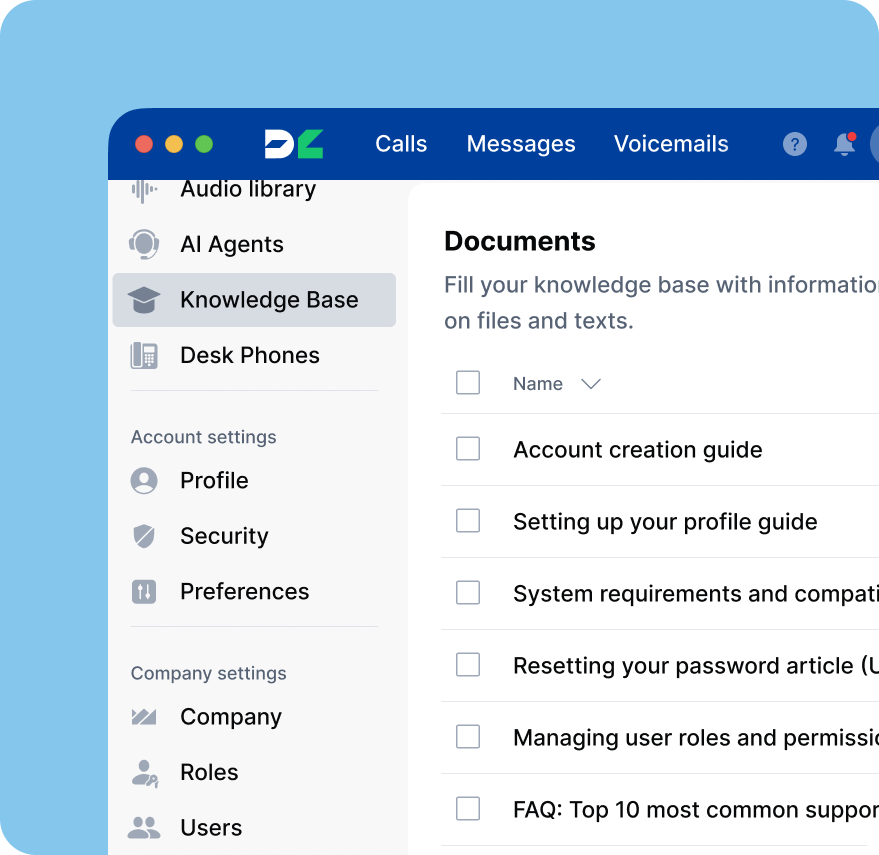
- MCP servers (Model Context Protocol): MCP servers let AI voice agents connect with multiple business tools and data sources, such as CRMs, calendars, or payment platforms, in real time. This allows the AI to retrieve information, update records, schedule meetings, or access account details during a live call, bridging the gap between automation and true task execution.
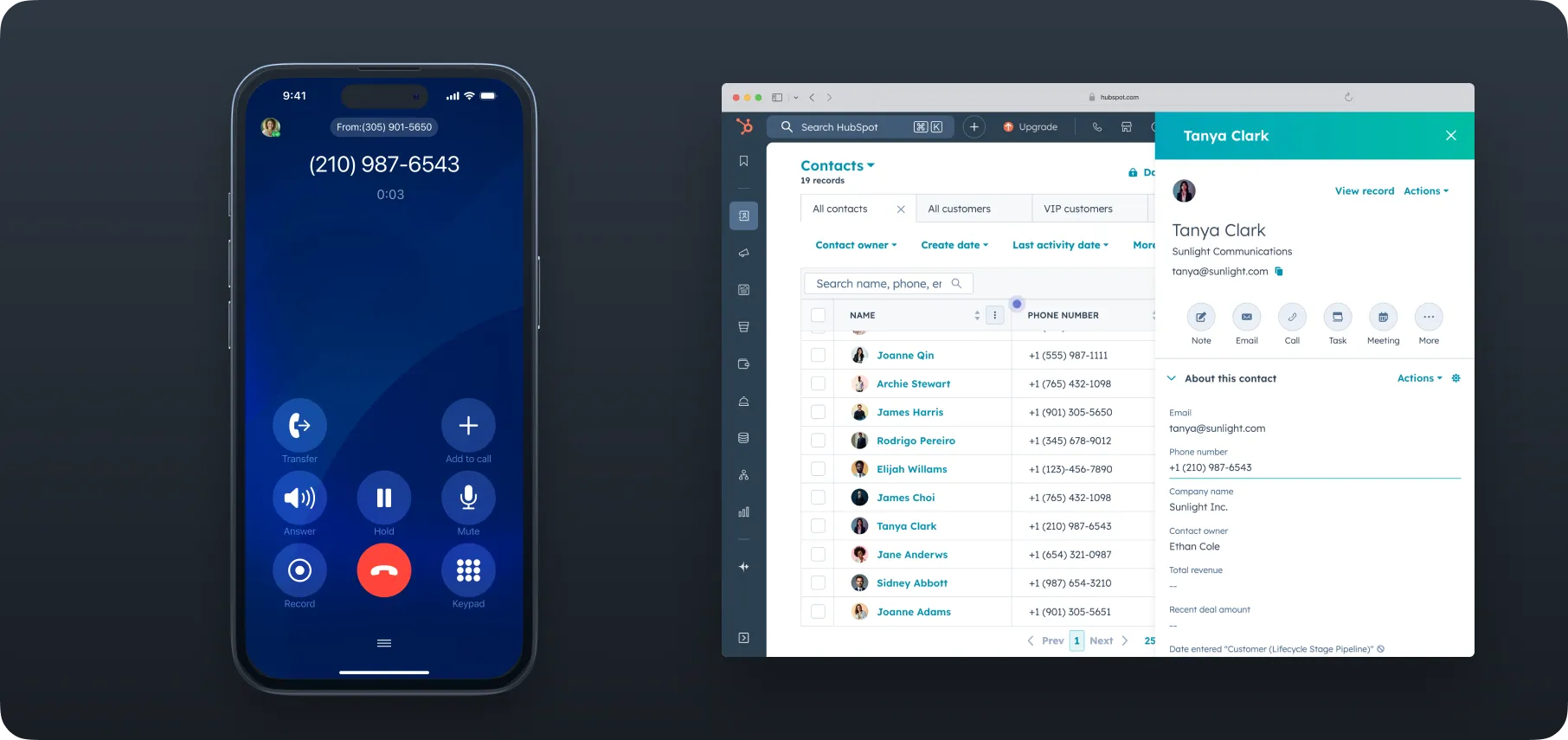
- Smart call routing: When a call goes beyond what AI can handle, or when the AI functions as a virtual receptionist, smart call routing directs the conversation to the right place. The AI can understand the caller’s intent, match it with predefined rules or keywords, and route it to the appropriate department or person for faster resolution.
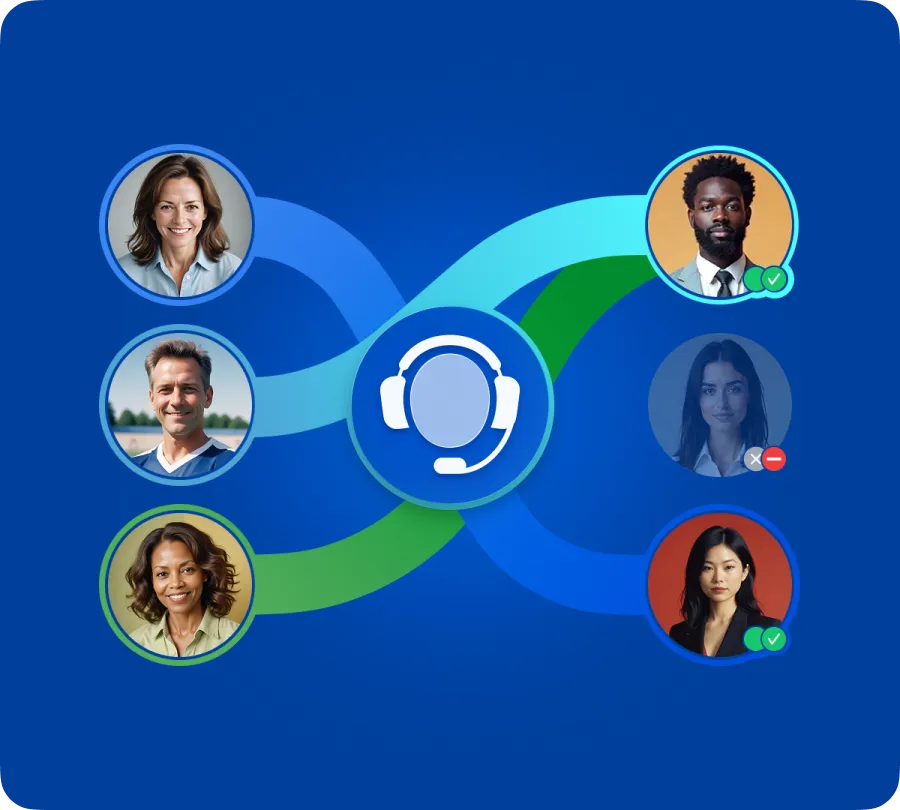
- Smooth AI–human handoff: When human intervention is needed, AI transfers the call seamlessly, sharing a transcript or summary so that the agent can take over without losing context. This ensures a natural transition and minimizes customer frustration.
- Multilingual support: Most modern AI call systems come equipped with multilingual capabilities, allowing them to understand and respond in multiple languages and dialects.
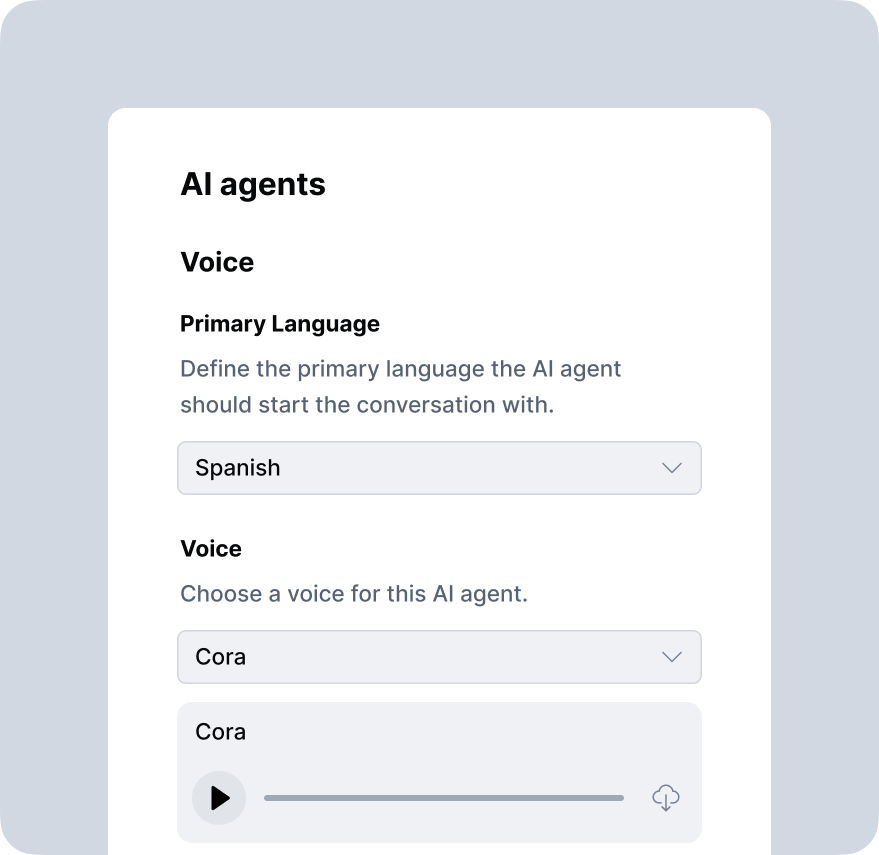
- AI call intelligence: Beyond real-time conversations, AI call systems also provide detailed post-call insights, including transcripts, action items, sentiment analysis, and call tagging.
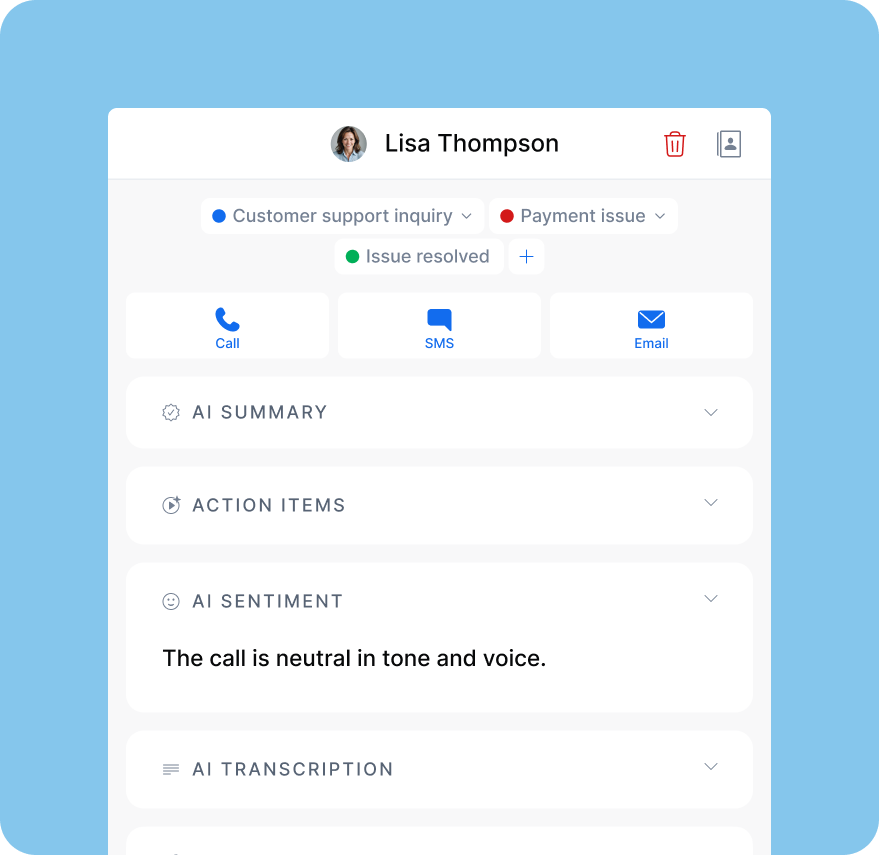
Real-World Examples of Artificial Intelligence Calls
While AI calls might sound futuristic, they’re already being used in highly practical ways across many industries. Here are some of the most common real-world applications:
Appointment Scheduling and Reminders
Healthcare clinics, salons, and service providers use AI voice agents to confirm, reschedule, or remind clients about appointments. Advanced AI can check calendar availability, offer alternative time slots, and update bookings automatically — all without human involvement.
Order Confirmations and Delivery Updates
E-commerce and food delivery companies rely on AI calls to confirm purchases, verify addresses, and provide real-time delivery updates. Some AI voice agents can even handle customer requests like adjusting delivery times or updating order details on the spot.
Customer Support and Troubleshooting
Instead of waiting on hold for a live agent, customers can get instant help through AI-powered calls. The AI can identify issues, walk users through step-by-step troubleshooting, and transfer them to a human representative if the problem requires further assistance.
Lead Qualification and Sales Outreach
Sales teams use AI voice agents to perform initial outreach, qualify leads, and capture essential details before handing them off to a sales rep. The AI can introduce the product, ask discovery questions, record responses, and even schedule follow-up meetings, helping teams scale outreach while maintaining a personalized touch.
Reservation and Booking Services
Hotels, restaurants, and travel agencies employ AI calls to handle reservations around the clock. These systems can take new bookings, modify existing ones, answer FAQs (like check-in policies or menu details), and suggest upgrades or add-ons in a conversational way.
Feedback Collection and Surveys
After a service or a purchase, AI voice agents conduct quick surveys to collect customer feedback. They can analyze sentiment, identify recurring issues, and summarize responses into actionable insights that help businesses improve service quality.
Emergency Alerts and Utility Notifications
Public services and utility providers use AI calls to instantly notify customers about outages, maintenance, or safety updates. Automated voice calls ensure information reaches large audiences quickly, clearly, and consistently.
Artificial Intelligence Calls in Call Centers
The use of artificial intelligence calls in call centers deserves special attention due to their wide applicability and proven success across industries. Call centers handle massive volumes of repetitive interactions every day — from answering customer questions to routing calls and collecting feedback.
By adopting call center artificial intelligence software, companies can automate routine inquiries, freeing up human agents to focus on more complex or emotionally sensitive cases. This not only improves efficiency and response times but also reduces operational costs while maintaining consistent service quality around the clock.
Modern artificial intelligence call center solutions go far beyond traditional IVR systems. They use natural language understanding to greet callers naturally, interpret their intent, and route the call appropriately — no more pressing menu options or repeating scripted phrases. Customers can simply speak as they normally would, while the AI identifies the request and provides an instant, accurate response.
For growing businesses, artificial intelligence for call centers opens new opportunities for scaling service without expanding headcount. With call center artificial intelligence services, companies can deliver 24/7 multilingual support, handle peak call volumes, and provide consistent customer experiences that sound human and personalized.
In addition, advanced systems equipped with multilingual AI agents make it possible for small businesses that can’t afford hiring local agents to serve customers in their native language while maintaining natural, human-like interactions.
What Can Your Small Business Achieve with Artificial Intelligence Phone Calls?
While large organizations often use AI phone calls primarily for automation, small businesses with limited resources can gain even greater advantages from this technology. Here’s what your business can achieve:
-
24/7 Availability — No More Missed Calls or Voicemails
With AI handling inbound calls around the clock, your business never misses an opportunity to connect. Whether it’s after hours, weekends, or holidays, an AI voice agent can answer questions, take messages, or process requests, ensuring customers always get a response instead of being stuck in voicemail.
-
Augmented Human Workload
Small businesses often operate with lean teams. AI calls help by taking over repetitive or time-consuming tasks, allowing your staff to focus on higher-value interactions and business growth.
-
Cost Savings on Staffing and Operations
Hiring a full-time receptionist or additional staff to manage basic support calls can be costly, especially for small businesses. With AI handling those routine calls around the clock, you can maintain excellent customer service without the overhead of extra salaries or extended hours, keeping operations efficient and cost-effective.
-
Faster Resolution for Routine Inquiries
By assigning AI voice agents to handle routine calls, you can improve efficiency on both ends: customers get instant responses to simple requests, while callers with more complex issues avoid long wait times caused by agents handling repetitive tasks. This balance ensures faster service, smoother workflows, and higher overall customer satisfaction.
Common Myths About Artificial Intelligence Calls
As artificial intelligence calls become more common, several myths still shape how people perceive the technology. Let’s clear up some of the most common misconceptions:
“AI calls sound robotic.” That may have been true in the past, but not anymore. Early AI systems relied on basic text-to-speech engines that produced flat, monotone voices. Modern speech-to-speech systems now replicate tone, rhythm, and emotion, making conversations sound natural and engaging. Many modern AI call solutions even allow businesses to choose or clone custom voices that match their brand’s personality, creating a more authentic and personable caller experience.
Talk to AiVA
Call this number to connect with our AI voice agent.
(305) 901-5650
Prefer a callback? Enter your number and AiVA will call you.
“AI will replace human agents.” AI calls aren’t about replacing people — they’re about augmenting them. AI voice agents excel at handling repetitive, routine, and time-consuming tasks without fatigue or stress, allowing teams to focus on more complex, high-value interactions that require empathy and judgment. Rather than taking jobs away, AI acts as a powerful assistant that lightens workloads and increases efficiency. When humans and AI work together, the result is a more scalable, productive, and customer-friendly operation.
“AI calls are expensive and reserved only for large enterprises.” That may have been true in the past, but not anymore. Today, AI voice agents are affordable and accessible even for small businesses. Providers like DialLink make it easy to implement AI voice agents without complex setup, allowing smaller teams to enjoy the same automation, availability, and professionalism once limited to large enterprises.
“AI calls can’t understand real conversations.” That might have been the case with early voice bots that struggled with accents, slang, and background noise. Today’s AI call systems use large language models (LLMs) and advanced speech recognition trained on diverse, global datasets. As a result, they can understand context, adapt to different speech patterns, and accurately interpret intent, even when phrasing isn’t exact. This enables them to handle real-world, unscripted conversations naturally and effectively.
Conclusion
Artificial intelligence calls have evolved far beyond the early days of robotic, pre-recorded voices. Today, they represent one of the most practical and transformative uses of AI in everyday business communication. From addressing routine questions to scheduling appointments, AI voice agents are quietly reshaping how businesses connect with customers.
By eliminating the limits of working hours, reducing operational costs, and ensuring that every customer interaction is answered, AI calls empower small businesses and startups to compete at an enterprise level.
If you’re ready to bring AI-powered calling to your business, explore DialLink’s business phone system — a unified platform that combines advanced call management with built-in AI voice agents, making AI an integral part of your phone infrastructure.
Not exactly. Although modern AI can sound remarkably natural, it still doesn’t sound exactly like a human. However, today’s advanced speech-to-speech (S2S) and neural text-to-speech (TTS) technologies allow AI voice agents to closely mirror human tone, rhythm, and emotion. As a result, AI calls now feel far more conversational and engaging than the robotic voices of the past.
To handle phone calls, AI technology must be connected to the platform where calls are made, such as a virtual phone system like DialLink. Once the AI solution is integrated into the phone system and linked to your business phone number, it can be activated to automatically answer incoming calls. From there, the AI voice agent can greet callers, answer questions, or route the call to the right person.
Yes. Some solutions allow AI voice agents to place outbound calls for tasks such as appointment reminders, lead qualification, order confirmations, feedback collection, and more.
To start using AI phone calls, you’ll need two key components:
- A business phone system — like DialLink, which provides the telephony infrastructure (numbers, call routing, and management tools).
- An AI voice agent — integrated directly into your phone system or connected through APIs to handle inbound and outbound calls.
Once set up, your AI voice agent can automatically answer calls, assist customers, route conversations, and even initiate outbound calls.
Share this post
In this article
- What Is an Artificial Intelligence Call? Why Is It Called Artificial Intelligence?
- Technology That Power Artificial Intelligence Calls
- The Main Features of AI Call Systems
- Real-World Examples of Artificial Intelligence Calls
- Artificial Intelligence Calls in Call Centers
- What Can Your Small Business Achieve with Artificial Intelligence Phone Calls?
- Common Myths About Artificial Intelligence Calls
- Conclusion

Arina Khoziainova
Content Writer at DialLink
Arina is a content writer with over 7 years of experience in the IT industry. At DialLink, she creates clear, insightful content that helps small business and startup owners simplify communication and drive growth using modern tools. With a strong focus on practical value, Arina transforms complex topics into accessible, actionable stories.
Keep Reading

How DialLink Leverages MCP to Streamline AI Integrations
Discover how DialLink leverages MCP to connect AI Voice Agents with AI models and business tools, enabling them to solve real business challenges.
October 07, 2025
15 minutes

Text-to-Speech and Speech-to-Speech: How Each Can Benefit Your Business?
Explore both technologies that power AI voice agents, their pros and cons, and how to choose the best fit for your business needs.
September 23, 2025
16 minutes

What Is MCP? A Guide to Model Context Protocol
Discover what Model Context Protocol (MCP) is, how it works, and why it’s revolutionizing AI voice agents, call automation, and integrations for SMBs and startups. Learn key benefits, detailed use cases, and future trends.
August 05, 2025
14 minutes

5 Ways AI Appointment Setters Streamline Your Business
Discover how AI appointment setters streamline your business by answering calls, automatically booking appointments directly into your calendar, and capturing lead data.
July 07, 2025
8 minutes